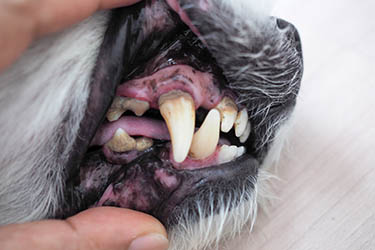What is the difference between gingivitis and stomatitis in dogs?

Gingivitis and stomatitis are both inflammatory conditions that can affect your dog’s oral health. These two conditions are often mixed up or assumed to be the same disease by dog owners, as they can present in similar ways. Although both gingivitis and stomatitis can be present in dogs, their nature is quite different, and it is important that dog owners know this.
Gingivitis
Gingivitis is the first warning sign of impending periodontal disease. In medical terms, gingivitis simply means “inflammation of the gums.”
Your dog’s mouth is full of bacteria that feed on fragments of food and other material that your dog picks up or licks. As the bacteria grow, they form a slimy biofilm called plaque, which coats the surfaces of the dog’s teeth. If preventative measures are not taken, the bacteria enter the gingival sulcus, the small pocket between the tooth and the gum, causing irritation and infection.
Within a matter of days, minerals in the dog’s saliva cause the plaque to harden into dental calculus (tartar). Plaque and tartar gradually extend below the gumline, causing irritation and inflammation. The gums quickly become red and swollen around the tooth margins. The dog may have difficulty eating due to the discomfort in their mouth; further, their gums may bleed, and they will almost always develop “doggy breath.”
If gingivitis is not treated promptly, the condition will readily progress to full-blown periodontal disease. Periodontal disease can cause extreme discomfort for your dog, and tooth loss will almost inevitably occur. In addition, bleeding gums can allow bacteria easy access to the bloodstream where they can be transported throughout the dog’s body. Inflammatory by-products are more harmful, especially if chronic as in periodontal disease, and can cause serious health problems.
Though gingivitis is preventable and curable, periodontitis is not.
In fact, brushing your dog’s teeth daily with a pet-specific toothpaste and attending regular veterinary dental checks will effectively prevent gingivitis.
Stomatitis
Stomatitis differs from periodontal disease in that it is primarily a paradental disease. This means that it does not usually affect the supportive tissues that attach the tooth to the socket in the dog’s jaw (alveolar bone, cementum, periodontal ligament, and gingiva).
Stomatitis typically impacts the soft, fleshy structures inside your dog’s mouth such as the pharynx, oral mucosa, inside of the cheeks, and tongue, as well as the gums, and is typically characterized by the formation of painful, persistent ulcers. Some dogs, especially spaniel breeds, also develop idiopathic osteomyelitis (inflammation of the bone and marrow).
As in cases of gingivitis, the bacteria inside your dog’s mouth can be responsible for triggering stomatitis, although for different reasons. Some dogs have a hypersensitive immune response to the bacteria that form a coating of plaque on the tooth surfaces. In these animals, excessive amounts of antibodies are produced by the body in order to tackle the invading bacteria, and it is these antibodies that initiate stomatitis.
Certain breeds of dogs are at a higher risk of developing stomatitis.
In particular, Cavalier King Charles spaniels, cocker spaniels, Maltese, and Bouvier des Flandres are known to be predisposed to stomatitis.
Stomatitis can also be caused by external triggers, including trauma, ingestion of caustic substances, certain autoimmune diseases, and foreign bodies such as bone and wood splinters becoming embedded in the soft tissue of the mouth.
Symptoms of Stomatitis
Some stomatitis symptoms are very similar to those presented by gingivitis—hence why the two conditions are often misdiagnosed by concerned dog owners. Usually, the only way to achieve a definitive and correct diagnosis is through veterinary examination.
If your dog shows any of the following symptoms, seek veterinary advice right away:
- foul “doggy” breath
- bleeding gums
- excessive drooling, sometimes containing blood
- reddened, swollen gums
- reluctance or difficulty eating
- poor appetite
- weight loss
- pawing at the mouth
- obvious lesions or ulcers on the gums (“kissing ulcers”)
- reluctance to groom himself
- depression
You may also notice small areas of inflammation, sometimes exuding pus, in the folds around your dog’s mouth.
Diagnosis of Stomatitis
Your vet will initially carry out an oral examination of your dog to determine whether the symptoms presented are due to gingivitis or stomatitis. In severe cases, where the dog is in extreme pain, this examination will be performed under anesthesia.
Other diagnostic procedures may include biopsies of the lesions to eliminate cancer or auto-immune diseases as a cause. In addition, standard blood tests, urinalysis, and an electrolyte panel will be taken to check that your dog is not suffering from any underlying conditions such as kidney disease or bacterial infections. In many cases, tooth extraction will be required and X-rays will be necessary so that the extent of bone involvement can be determined.
Treatment of Stomatitis
There are several treatments that can be used to ease the symptoms caused by stomatitis.
Antibiotic, anti-inflammatory, and analgesic therapies can be used to provide immediate relief, especially where the condition is widespread. However, in chronic cases, this treatment regimen often just brings temporary relief. Immunosuppressant drugs can be very effective in some dogs, as they help to control outbreaks of stomatitis by damping down the animal’s immune response. However, not all dogs can tolerate these drugs. Steroids can also be effective, but long-term use can be problematic in that it can cause liver and other issues.
Once the condition is controlled, it will be vital that owners clean their respective dog’s teeth every day and that frequent professional veterinary cleanings are carried out.
However, when other treatments have failed to bring lasting relief, the only option may be to remove all of the dog’s teeth, thus preventing the formation of plaque and therefore removing the trigger for the disease. Although this may sound drastic, it is usually successful and will allow your dog to enjoy a pain-free and happy live afterward.
Differences between gingivitis and stomatitis
- Gingivitis and stomatitis are two separate conditions with different causes.
- Stomatitis presents with very similar symptoms to gingivitis, often leading to confusion and misdiagnosis by concerned dog owners.
- Although stomatitis can be managed via drug therapy, a full-mouth extraction of the teeth may be the only way to completely cure the disease.
- Left undiagnosed and untreated, stomatitis can encourage gingivitis to develop, leading to periodontal disease
About Dr. James Anthony
Dr. James Anthony has been involved in veterinary medicine for
over 30 years. He is a boarded Veterinary Dentist since 1989 (Diplomate of the AVDC).
Dr. Anthony has had an extensive academic career as well, having
taught veterinary dentistry at the University of Guelph, the University of Montreal and the University of Prince Edward Island. He was also a Tenured Professor at the University of Saskatchewan as the Head of
Veterinary Oral Surgery and Dentistry.
Dr. Anthony has authored over 40 articles and book chapters, and throughout his career has lectured globally at veterinary meetings.


Working Here
Our team members are encouraged to be the best they can be... at Covetrus we believe we impact one another.
Learn MoreNews & Events
FDA Cautions Pet Owners Not to Feed Texas Tripe Inc. Raw Pet Food Due to Salmonella, Listeria Monocytogenes
The U.S. Food and Drug Administration is cautioning pet owners not to feed their pets any of the Texas Tripe brand raw frozen pet food listed below because several samples of Texas Tripe raw pet food have tested positive for Salmonella and/or L. mono.
Careers
Are you looking for a place to let your talents shine? At Covetrus, we help our practitioner customers better serve their patients and take pride in providing the best customer experience possible. Search our open positions to see our available opportunities.
Newsletter
Stay current with what’s going on with Covetrus, subscribe to receive our newsletter and email communications. Subscribers will receive the latest information in practice management, sales and marketing, animal health, and more.



-3-(1).png?sfvrsn=2d806d73_0)

Leave a comment